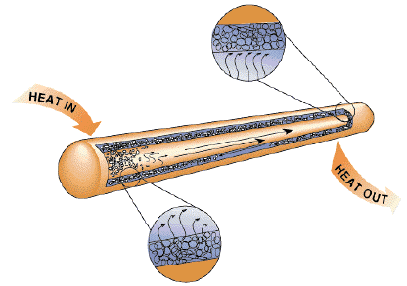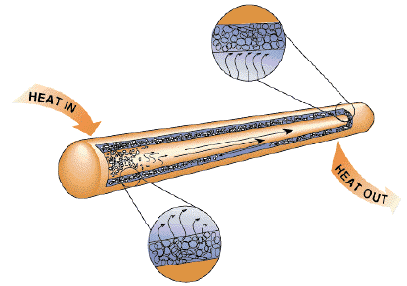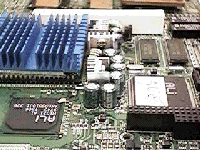Chemical and Process Engineering Resources

Working Principle and Applications
Inside the container is a liquid under its own pressure, that enters the pores of the capillary material, wetting all internal surfaces. Applying heat at any point along the surface of the heat pipe causes the liquid at that point to boil and enter a vapor state. When that happens, the liquid picks up the latent heat of vaporization. The gas, which then has a higher pressure, moves inside the sealed container to a colder location where it condenses. Thus, the gas gives up the latent heat of vaporization and moves heat from the input to the output end of the heat pipe.
 |
| Figure 1: Heat Flowing Through a Heat Pipe |
Heat pipes have an effective thermal conductivity many thousands of times that of copper. The heat transfer or transport capacity of a heat pipe is specified by its " Axial Power Rating (APC)". It is the energy moving axially along the pipe. The larger the heat pipe diameter, greater is the APR. Similarly, longer the heat pipe lesser is the APR. Heat pipes can be built in almost any size and shape.
Heat pipe has been, and is currently being, studied for a variety of applications, covering almost the entire spectrum of temperatures encountered in heat transfer processes. Heat pipes are used in a wide range of products like air-conditioners, refrigerators, heat exchangers, transistors, capacitors, etc. Heat pipes are also used in laptops to reduce the working temperature for better efficiency. Their application in the field of cryogenics is very significant, especially in the development of space technology. We shall now discuss a brief account of the various applications of heat pipe technology.
Space Technology
The use of heat pipes has been mainly limited to this field of science until recently, due to cost effectiveness and complex wick construction of heat pipes. There are several applications of heat pipes in this field like
- Spacecraft temperature equalization
- Component cooling, temperature control and radiator design in satellites.
- Other applications include moderator cooling, removal of heat from the reactor at emitter temperature and elimination of troublesome thermal gradients along the emitter and collector in spacecrafts.
Dehumidification and Air Conditioning
In an air conditioning system, the colder the air as it passes over the cooling coil (evaporator), the more the moisture is condensed out. The heat pipe is designed to have one section in the warm incoming stream and the other in the cold outgoing stream. By transferring heat from the warm return air to the cold supply air, the heat pipes create the double effect of pre-cooling the air before it goes to the evaporator and then re-heating it immediately.
Activated by temperature difference and therefore consuming no energy, the heat pipe, due to its pre-cooling effect, allows the evaporator coil to operate at a lower temperature, increasing the moisture removal capability of the air conditioning system by 50-100%. With lower relative humidity, indoor comfort can be achieved at higher thermostat settings, which results in net energy savings. Generally, for each 1° F rise in thermostat setting, there is a 7% savings in electricity cost. In addition, the pre-cooling effect of the heat pipe allows the use of a smaller compressor.
Laptop Cooling
Heat pipe technology originally used for space applications has been applied it to laptop computer cooling. It is an ideal, cost effective solution. Its light weight (generally less than 40 grams), small, compact profile, and its passive operation, allow it to meet the demanding requirements of laptops.
For an 8 watt CPU with an environmental temperature no greater than 40°C it provides a 6.25°C/watt thermal resistance, allowing the processor to run at full speed under any environmental condition by keeping the case temperature at 90°C or less.
 |
| Figure 2: Heat Sink Inside a Laptop |
One end of the heat pipe is attached to the processor with a thin, clip-on mounting plate. The other is attached to the heat sink, in this case, a specially designed keyboard RF shield. This approach uses existing parts to minimize weight and complexity. The heat pipe could also be attached to other physical components suitable as a heat sink to dissipate heat. (See photo of inside of laptop computer).
Because there are no moving parts, there is no maintenance and nothing to break. Some are concerned about the possibility of the fluid leaking from the heat pipe into the electronics. The amount of fluid in a heat pipe of this diameter is less than 1cc. In a properly designed heat pipe, the water is totally contained within the capillary wick structure and is at less than 1 atmosphere of pressure. If the integrity of the heat pipe vessel were ever compromised, air would leak into the heat pipe instead of the water leaking out. Then the fluid would slowly vaporize as it reaches its atmospheric boiling point. A heat pipe’s MTTF is estimated to be over 100,000 hours of use.

 FB
FB

0 Comments